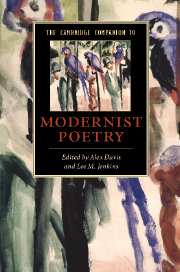Introduction
Published online by Cambridge University Press: 28 November 2007
Summary
In 1921, T. S. Eliot declared that 'poets in our civilization . . . must be difficult'. The publication in the following year of The Waste Land served to confirm the truth of this pronouncement: Eliot's bristlingly allusive poem, and its seven pages of accompanying notes, insists that 'difficulty' is a sine qua non of the modernist artwork. For other practitioners of modernist poetics, like William Carlos Williams, the learnedness of Eliot's poem returned poetry to the classroom: arguably, however, Williams's democratic model of modernist poetry requires as much exegesis for the twenty-first-century reader as Eliot's elitist masterpiece. After all, critics have expended as much ingenuity in surmising what depends on Williams's red wheelbarrow, in his sixteen-word poem of that title, as they have in pursuing the meaning of Tarot cards and the Holy Grail in Eliot's pocket epic. Between the polar extremes represented by Eliot and Williams we find a heterogeneous array of modernist poetries. The broad church of poetic modernism includes Wallace Stevens's post-Arnoldian idea of poetry as a substitute for religion; the avant-garde 'écriture feminine' of H.D. (Hilda Doolittle) and Mina Loy; and the cultural nationalisms of African-American and certain Irish and Scottish poetry of the period.
Modernist poetry involves recuperations of history and Futurist and Dada abandonments of tradition; arcane and demotic registers of language; elitist and populist forms of literature. The rich diversity of modernist poetries, no less than the particular difficulties presented by The Waste Land, inevitably necessitates the kind of 'classroom assistance' Williams believed the 'new art' was on the point of escaping.
- Type
- Chapter
- Information
- The Cambridge Companion to Modernist Poetry , pp. 1 - 8Publisher: Cambridge University PressPrint publication year: 2007
- 2
- Cited by



